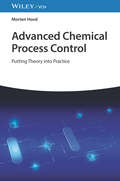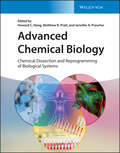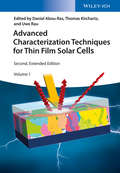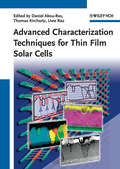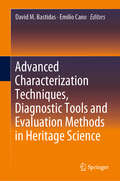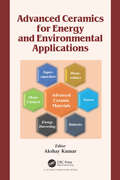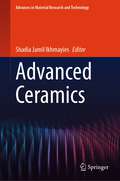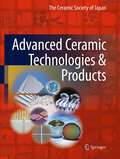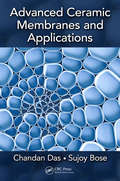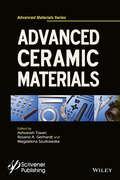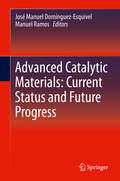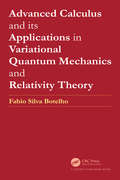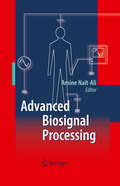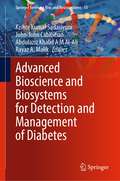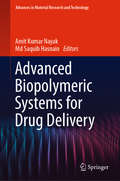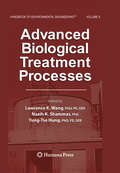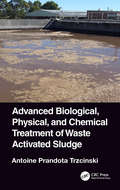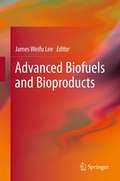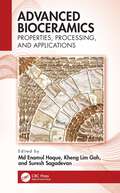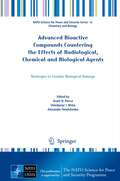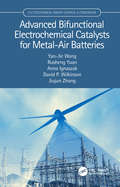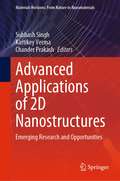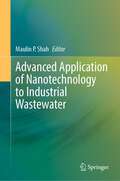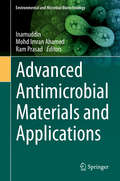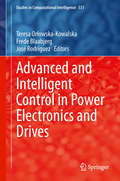- Table View
- List View
Advanced Chemical Process Control: Putting Theory into Practice
by Morten HovdAdvanced Chemical Process Control Bridge the gap between theory and practice with this accessible guide Process control is an area of study which seeks to optimize industrial processes, applying different strategies and technologies as required to navigate the variety of processes and their many potential challenges. Though the body of chemical process control theory is robust, it is only in recent decades that it has been effectively integrated with industrial practice to form a flexible toolkit. The need for a guide to this integration of theory and practice has therefore never been more urgent. Advanced Chemical Process Control meets this need, making advanced chemical process control accessible and useful to chemical engineers with little grounding in the theoretical principles of the subject. It provides a basic introduction to the background and mathematics of control theory, before turning to the implementation of control principles in industrial contexts. The result is a bridge between the insights of control theory and the needs of engineers in plants, factories, research facilities, and beyond. Advanced Chemical Process Control readers will also find: Detailed overview of Control Performance Monitoring (CPM), Model Predictive Control (MPC), and more Discussion of the cost benefit analysis of improved control in particular jobs Authored by a leading international expert on chemical process control Advanced Chemical Process Control is essential for chemical and process engineers looking to develop a working knowledge of process control, as well as for students and graduates entering the chemical process control field.
Advanced Chemical Biology: Chemical Dissection and Reprogramming of Biological Systems
by Howard HangAdvanced Chemical Biology The modern approach to teaching chemical biology Advanced Chemical Biology is organized around the central dogma of life, progressing from genes to proteins and higher-order cellular structures, including core application areas such as imaging, chemical genetics, activity-based protein profiling, and natural product discovery and biosynthesis. Advanced topics and applications in, e. g., microbiology, developmental biology, and neurobiology, are covered in separate sections. Every chapter is homogeneous in style and layout, consisting of a short historical introduction followed by a description of the underlying concepts and a selection of recent examples of how the concept has been turned into practice. The subdivision of the contents into core and supplemental chapters enables a flexible use in teaching, both for a one-semester and a two-semester course. Written by authors and editors coming from the leading scientific institutions that have developed the concepts and technologies for this discipline, Advanced Chemical Biology includes specific information on topics like: DNA function, synthesis and engineering, chemical approaches to genome integrity, and RNA function, synthesis, and probing Chemical approaches to transcription and RNA regulation in vivo, chemical biology of genome engineering, and peptide/protein synthesis and engineering Directed evolution for chemical biology, chemical biology of cellular metabolism, chemical biology of lipids, and protein post-translational modifications Chemical glycobiology, chemical and enzymatic modification of proteins, genetic code expansion, bio-orthogonal chemistry, and cellular imaging With its broad scope and focus on turning concepts into applications, Advanced Chemical Biology is an excellent starting point for anyone entering the field and looking for a guide to the wide range of available methods and strategies that chemical biology has to offer. With a Foreword by Nobel Laureate Carolyn Bertozzi.
Advanced Characterization Techniques for Thin Film Solar Cells
by Daniel Abou-Ras Uwe Rau Thomas KirchartzThe book focuses on advanced characterization methods for thin-film solar cells that have proven their relevance both for academic and corporate photovoltaic research and development. After an introduction to thin-film photovoltaics, highly experienced experts report on device and materials characterization methods such as electroluminescence analysis, capacitance spectroscopy, and various microscopy methods. In the final part of the book simulation techniques are presented which are used for ab-initio calculations of relevant semiconductors and for device simulations in 1D, 2D and 3D. Building on a proven concept, this new edition also covers thermography, transient optoelectronic methods, and absorption and photocurrent spectroscopy.
Advanced Characterization Techniques for Thin Film Solar Cells
by Daniel Abou-Ras Uwe Rau Thomas KirchartzWritten by scientists from leading institutes in Germany, USA and Spain who use these techniques as the core of their scientific work and who have a precise idea of what is relevant for photovoltaic devices, this text contains concise and comprehensive lecture-like chapters on specific research methods. They focus on emerging, specialized techniques that are new to the field of photovoltaics yet have a proven relevance. However, since new methods need to be judged according to their implications for photovoltaic devices, a clear introductory chapter describes the basic physics of thin-film solar cells and modules, providing a guide to the specific advantages that are offered by each individual method. The choice of subjects is a representative cross-section of those methods enjoying a high degree of visibility in recent scientific literature. Furthermore, they deal with specific device-related topics and include a selection of material and surface/interface analysis methods that have recently proven their relevance. Finally, simulation techniques are presented that are used for ab-initio calculations of relevant semiconductors and for device simulations in 1D and 2D. For students in physics, solid state physicists, materials scientists, PhD students in material sciences, materials institutes, semiconductor physicists, and those working in the semiconductor industry, as well as being suitable as supplementary reading in related courses.
Advanced Characterization Techniques, Diagnostic Tools and Evaluation Methods in Heritage Science
by David M. Bastidas Emilio CanoThis book details the application of advanced characterisation techniques and diagnostic tools to heritage science, including the evaluation of heritage assets’ condition, their preservation and restoration. <p><p> It examines the use of electrochemical techniques in conservation science, with a particular focus on how to solve problems in taking on-site measurements. Specifically, it introduces readers to a new gel polymer (GPE) electrochemical cell developed by the authors for the characterisation of metallic heritage objects. Other techniques used to characterise and monitor reinforced concrete objects in more modern buildings are also covered, including non-destructive electrochemical techniques that allow steel corrosion to be assessed in these structures, and in those that are used to protect and repair such buildings. <p> The usefulness of the NMR-Mouse nuclear magnetic resonance sensor in the assessment and preservation of softer heritage materials, such as wood, parchment, bone, and painted walls, is covered, as well as Infrared reflectography for examining paintings and laser cleaning for restoring them. The book introduces ultra-High Performance Liquid Chromatography (u-HPLC) with a diode-array (DAD) and mass–mass (MS-MS) quadruple time-of-flight spectroscopy (QTOF). This new technique can be applied to the analysis and identification of natural and synthetic organic pigments and its use is demonstrated in several case studies. <p> This book provides a rigorous scientific grounding in the application of state-of-the-art techniques in heritage science and conservation, and offers a practical handbook for practitioners.
Advanced Ceramics for Energy and Environmental Applications
by Akshay KumarAdvanced Ceramics possess various unique properties and are able to withstand harsh environments. The aim of this book is to cover various aspects of the advanced ceramics like carbides, nitrides and oxides for energy and environment related applications. Advanced ceramics with additional functionality propose significant potential for greater impact in the field of energy and environmental technologies. This book focuses on the nanostructured ceramics synthesis, properties, structure-property relation and application in the area of energy and environment. It covers the high impact work from around 50 leading researchers throughout the world working in this field. This will help metallurgists, biologists, mechanical engineers, ceramicists, material scientists and researchers working in the nanotechnology field with inclusion of every aspect of advanced ceramics for energy and environmental applications.
Advanced Ceramics (Advances in Material Research and Technology)
by Shadia Jamil IkhmayiesThis book presents the fundamentals of advanced ceramics, their stages of development, types and classifications, advanced processing techniques, properties, sintering, and new forms of applications. It highlights specific examples such as alumina, zirconia, Mg-Al-spinels, silicon carbide, silicon nitride, ceramic composites, and thin films with their specific applications. The book reviews progress in perovskite ceramics, in which the synthesis, processing, characterization, and advanced applications of perovskite ceramics are all thoroughly discussed. In addition, developments of perovskite solar cells, the main factors affecting their stability, current problems, development prospects in the research, and application of perovskite solar cells are all highlighted. This book also includes a review of a particular class of rare-earth-based mixed-metal oxides, namely Ln2B2O7 nanostructures (B = Zr, Sn, and Ce), where advantages and disadvantages of each production technique are addressed along with the properties of as-produced nanostructures. The solar photocatalytic uses of Ln2B2O7 nanostructures such as photodegradation of contaminants are also discussed. Yttria-based transparent ceramics for photonic applications are reviewed, along with a discussion of powder synthesis, green body preparation, sintering, and optical properties. In addition, the fundamentals of electrophoretic deposition of hydroxyapatite incorporated composite coatings on metallic substrates are presented and discussed. The different types of ceramics-based self-healing coatings and their fabrication processes have also been reported and discussed in this book. These include titania, zirconia, titanium-alumina, and zirconia-alumina incorporated with Benzotriazole (BTA) as an inhibitor. Advanced ceramic materials that have been used for the purpose of wastewater treatment including ceramic sorbents, resins, aerosols, and ceramic membranes that have been widely used for wastewater treatment purposes are also discussed in depth.Moreover, the book presents the preparation of geopolymers by microwave treatments and explains how their properties can be tuned using microwaves. Furthermore, the future and perspective of these advanced ceramic materials and their modifications to ensure better efficacy toward environmental remediation purposes are highlighted in this book.
Advanced Ceramic Technologies & Products
by The Ceramic Society of JapanSince the last century, ceramics have become essential to modern society and our daily lives. They have become an indispensable product to many industries, especially within the fields of electronics, automobiles, medicine, and leisure. Japanese ceramic technologies and products are highly sophisticated and world renown, and ceramic products have long contributed to Japanese society. The true significance of ceramics to modern society however, is not well understood. This book describes in detail the background to and objective of the development, materials, manufacturing processes, functions and future prospects of a number of ceramic products. Not merely about the science and technology of ceramic manufacturing, the book is about the products themselves, as it tries to clarify how ceramics continue to contribute to our lives. It is the first such work to show advanced ceramic products in detail, from the technologies used to their application, and can be seen as a kind of illustrated reference book for modern advanced ceramic products as it is filled with easy-to-understand illustrations and photos. By including past and current product technologies, the editors hope the book will serve to guide engineers and the manufacturing sector toward a bright future of innovations for the benefit of us all.
Advanced Ceramic Membranes and Applications
by Chandan Das Sujoy BoseThis book provides a balanced blend of fundamental concepts of fabrication, characterization of conventional ceramics, extending to present the recent advances in ceramic membranes. It covers the basic concepts of ceramic membranes as well as practical and theoretical knowledge in conventional and advanced ceramic membranes combined with unorthodox ideas for novel approaches in ceramic membranes. Book includes lot of real time examples derived largely from research work by authors. Aimed at researchers, students and academics in the field of membrane engineering around the globe, it has following key features: Guides readers through manufacturing, characterizing and using low-cost ceramic technology. Provides an overview of the different types of ceramic membranes, catalytic reactors and their uses. Covers industrial application, separation and purification. Includes recent developments and advances in membrane fabrication. Discusses new raw materials for ceramic membranes.
Advanced Ceramic Materials
by Magdalena Szutkowska Ashutosh Tiwari Rosario A. GerhardtCeramic materials are inorganic and non-metallic porcelains, tiles, enamels, cements, glasses and refractory bricks. Today, "ceramics" has gained a wider meaning as a new generation of materials influence on our lives; electronics, computers, communications, aerospace and other industries rely on a number of their uses. In general, advanced ceramic materials include electro-ceramics, optoelectronic-ceramics, superconductive ceramics and the more recent development of piezoelectric and dielectric ceramics. They can be considered for their features including mechanical properties, decorative textures, environmental uses, energy applications, as well as their usage in bio-ceramics, composites, functionally graded materials, intelligent ceramics and so on. Advanced Ceramic Materials brings together a group of subject matter experts who describe innovative methodologies and strategies adopted in the research and development of the advanced ceramic materials. The book is written for readers from diverse backgrounds across chemistry, physics, materials science and engineering, medical science, pharmacy, environmental technology, biotechnology, and biomedical engineering. It offers a comprehensive view of cutting-edge research on ceramic materials and technologies. Divided into 3 parts concerning design, composites and functionality, the topics discussed include: Chemical strategies of epitaxial oxide ceramics nanomaterials Biphasic, triphasic and multiphasic calcium orthophosphates Microwave assisted processing of advanced ceramic composites Continuous fiber reinforced ceramic matrix composites Yytria and magnesia doped alumina ceramic Oxidation induced crack healing SWCNTs vs MWCNTs reinforcement agents Organic and inorganic wastes in clay brick production Functional tantalum oxides Application of silver tin research on hydroxyapatite
Advanced Catalytic Materials: Current Status and Future Progress
by José Manuel Domínguez-Esquivel Manuel RamosThis book presents advances in computational methods, experimental synthesis, and advanced characterizations for novel catalytic materials. The authors show how catalytical materials can be used for various engineering oil & gas applications – mainly in low contaminants fuel production. All contributors, describe in detail novel experimental and theoretical techniques techniques and concepts for synthesis, evaluation and scaling catalytic materials and research advances in evaluation, extensive characterization and theoretical modeling using computer assisted methods and algorithms.Describes computational methods, experimental synthesis and advanced characterization for novel catalytic materials;Examines catalytic materials and corresponding engineering applications with a focus on low contaminant fuel production and derivatives;Covers the application of computer assisted quantum mechanical for fundamental understanding of electronic structure of molecular dimension catalytic materials.
Advanced Calculus and its Applications in Variational Quantum Mechanics and Relativity Theory
by Fabio Silva BotelhoThe first part of this book reviews some key topics on multi-variable advanced calculus. The approach presented includes detailed and rigorous studies on surfaces in Rn which comprises items such as differential forms and an abstract version of the Stokes Theorem in Rn. The conclusion section introduces readers to Riemannian geometry, which is used in the subsequent chapters. The second part reviews applications, specifically in variational quantum mechanics and relativity theory. Topics such as a variational formulation for the relativistic Klein-Gordon equation, the derivation of a variational formulation for relativistic mechanics firstly through (semi)-Riemannian geometry are covered. The second part has a more general context. It includes fundamentals of differential geometry. The later chapters describe a new interpretation for the Bohr atomic model through a semi-classical approach. The book concludes with a classical description of the radiating cavity model in quantum mechanics.
Advanced Biosignal Processing
by Amine Nait-AliThrough 17 chapters, this book presents the principle of many advanced biosignal processing techniques. After an important chapter introducing the main biosignal properties as well as the most recent acquisition techniques, it highlights five specific parts which build the body of this book. Each part concerns one of the most intensively used biosignals in the clinical routine, namely the Electrocardiogram (ECG), the Elektroenzephalogram (EEG), the Electromyogram (EMG) and the Evoked Potential (EP). In addition, each part gathers a certain number of chapters related to analysis, detection, classification, source separation and feature extraction. These aspects are explored by means of various advanced signal processing approaches, namely wavelets, Empirical Modal Decomposition, Neural networks, Markov models, Metaheuristics as well as hybrid approaches including wavelet networks, and neuro-fuzzy networks. The last part, concerns the Multimodal Biosignal processing, in which we present two different chapters related to the biomedical compression and the data fusion. Instead organising the chapters by approaches, the present book has been voluntarily structured according to signal categories (ECG, EEG, EMG, EP). This helps the reader, interested in a specific field, to assimilate easily the techniques dedicated to a given class of biosignals. Furthermore, most of signals used for illustration purpose in this book can be downloaded from the Medical Database for the Evaluation of Image and Signal Processing Algorithm. These materials assist considerably the user in evaluating the performances of their developed algorithms. This book is suited for final year graduate students, engineers and researchers in biomedical engineering and practicing engineers in biomedical science and medical physics.
Advanced Bioscience and Biosystems for Detection and Management of Diabetes (Springer Series on Bio- and Neurosystems #13)
by Kishor Kumar Sadasivuni John-John Cabibihan Abdulaziz Khalid A M Al-Ali Rayaz A. MalikThis book covers the medical condition of diabetic patients, their early symptoms and methods conventionally used for diagnosing and monitoring diabetes. It describes various techniques and technologies used for diabetes detection. The content is built upon moving from regressive technology (invasive) and adapting new-age pain-free technologies (non-invasive), machine learning and artificial intelligence for diabetes monitoring and management. This book details all the popular technologies used in the health care and medical fields for diabetic patients. An entire chapter is dedicated to how the future of this field will be shaping up and the challenges remaining to be conquered. Finally, it shows artificial intelligence and predictions, which can be beneficial for the early detection, dose monitoring and surveillance for patients suffering from diabetes
Advanced Biopolymeric Systems for Drug Delivery (Advances in Material Research and Technology #133)
by Amit Kumar Nayak Md Saquib HasnainThis book discusses the recent innovations in the development of various advanced biopolymeric systems, including gels, in situ gels, hydrogels, interpenetrating polymer networks (IPNs), polyelectrolyte complexes (PECs), graft co-polymers, stimuli-responsive polymers, polymeric nanoparticles, nanocomposites, polymeric micelles, dendrimers, liposomes and scaffolds. It also examines their applications in drug delivery.
Advanced Biological Treatment Processes: Volume 9 (Handbook of Environmental Engineering #9)
by Lawrence K. Wang Yung-Tse Hung Nazih K. ShammasVolume 9: Advanced Biological Treatment Processes in the Handbook of Environmental Engineering series provides critical insight into pollution-abatement engineering. This outstanding collection of methodologies is designed as a review of engineering systems currently being used, as well as their potential for use in pollution abatement. The book's expert panel of authors provides a look at a range of topics, including principles and kinetics of biological processes, vertical shaft bioreactors, upflow sludge blanket filtration, membrane bioreactors, column bioreactor, SBR, nitrification, denitrification, and emerging biological processes. Volume 9: Advanced Biological Treatment Processes and its sister book - Volume 8: Biological Treatment Processes - are indispensable as both basic biological treatment textbooks and comprehensive reference books for advanced undergraduate and graduate students, designers of waste treatment systems, scientists, and researchers. A gold-standard addition to The Humana Press series, Volume 9: Advanced Biological Treatment Processes gives readers a cutting-edge illustration of the theory and practice of biological abatement systems and their critical role in environmental issues today.
Advanced Biological, Physical, and Chemical Treatment of Waste Activated Sludge
by Antoine Prandota TrzcinskiRecently, research efforts aiming to improve energy efficiency of wastewater treatment processes for large centralized wastewater treatment plants (WWTPs) have been increasing. Global warming impacts, energy sustainability, and biosolids generation are among several key drivers towards the establishment of energy-efficient WWTPs. WWTPs have been recognized as major contributors of greenhouse gas emissions as these are significant energy consumers in the industrialized world. The quantity of biosolids or excess waste activated sludge produced by WWTP will increase in the future due to population growth and this pose environmental concerns and solid waste disposal issues. Due to limited capacity of landfill sites, more stringent environmental legislation, and air pollution from incineration sites, there is a need to rethink the conventional way of dealing with wastewater and the sludge production that comes with it. This book provides an overview of advanced biological, physical and chemical treatment with the aim of reducing the volume of sewage sludge. Provides a comprehensive list of processes aiming at reducing the volume of sewage sludge and increasing biogas production from waste activated sludge. Includes clear process flowsheet showing how the process is modified compared to the conventional waste activated sludge process. Provides current technologies applied on full scale plant as well as methods still under investigation at laboratory scale. Offers data from pilot scale experience of these processes
Advanced Biofuels and Bioproducts
by James W. LeeDesigned as a text not only for students and researchers, but anyone interested in green technology, Advanced Biofuels and Bioproducts offers the reader a vast overview of the state-of-the-art in renewable energies. The typical chapter sets out to explain the fundamentals of a new technology as well as providing its context in the greater field. With contributions from nearly 100 leading researchers across the globe, the text serves as an important and timely look into this rapidly expanding field. The 40 chapters that comprise Advanced Biofuels and Bioproducts are handily organized into the following 8 sections: · Introduction and Brazil's biofuel success · Smokeless biomass pyrolysis for advanced biofuels production and global biochar carbon sequestration · Cellulosic Biofuels · Photobiological production of advanced biofuels with synthetic biology · Lipids-based biodiesels · Life-cycle energy and economics analysis · High-value algal products and biomethane · Electrofuels
Advanced Bioceramics: Properties, Processing, and Applications
by Md Enamul Hoque Kheng Lim Goh Suresh SagadevanAdvanced Bioceramics: Properties, Processing, and Applications describes development of bioceramics and biocomposites, which are used in various biomedical applications including bone tissue repair, remodelling and regeneration. It covers the fundamental aspects of materials science and bioengineering, clinical performance in a variety of applications, ISO/ASTM specifications, and opportunities and challenges. • Offers a comprehensive view of properties and processing of bioceramics. • Highlights applications in dentistry, orthopaedic and maxillofacial implants, and regenerative and tissue engineering. • Covers ISO/ASTM specifications such as processing, clinical applications, recycling/reuse and disposal standards. • Explores health, environmental and ethical issues. With contributions from eminent editors and recognized authors around the world, this book should serve as an important reference for academics, scientists, researchers, students and practitioners in materials science and biomedical engineering. It is to assist in the design of novel, targeted and personalised bioceramic-based solutions to advanced healthcare.
Advanced Bioactive Compounds Countering the Effects of Radiological, Chemical and Biological Agents: Strategies to Counter Biological Damage (NATO Science for Peace and Security Series A: Chemistry and Biology)
by Volodymyr I. Mizin Alexander Omelchenko Grant N. PierceThe probability for exposure to damaging radiation, toxic chemicals in the environment and adverse biological agents has increased exponentially today. The more frequent and faster travel that we experience today also escalates the risk of contraction and transmission of potentially deadly infections. This has created a very real and escalating risk for injuries and deaths. This is accentuated in the military and medical staff that is more frequently exposed to radiological, chemical, and biological agents in their normal working environment. Understanding the mechanisms whereby these toxic agents inflict damage to our bodies is essential to prepare us for these challenges. Much of the damage is inflicted through the generation of free radicals and non-radical oxidants which then act through oxidative mechanisms to injury the body. This volume will discuss the damage caused by these radiological, chemical, and biological environmental stressors, the mechanisms through which the damage can occur and the novel strategies that can be used to reduce the injury inflicted by these toxic compounds. Using basic and clinical research approaches, the contents of this book discuss new ideas for the development of bioactive products and environmental approaches to lessen or negate the biological damage inflicted by these noxious compounds.
Advanced Bifunctional Electrochemical Catalysts for Metal-Air Batteries (Electrochemical Energy Storage and Conversion)
by Yan-Jie Wang Rusheng Yuan Anna Ignaszak David P. Wilkinson Jiujun ZhangMetal-air batteries (MABs) have attracted attention because of their high specific energy, low cost, and safety features. This book discusses science and technology including material selection, synthesis, characterization, and their applications in MABs. It comprehensively describes various composite bifunctional electrocatalysts, corrosion/oxidation of carbon-containing air cathode catalysts, and how improvements can be achieved in the catalytic activities of oxygen reduction reaction and oxygen evolution reaction and their durability/stability. This book also analyzes, compares, and discusses composite bifunctional electrocatalysts in the applications of MABs, matching the fast information of commercial MABs in requirements. Aimed at researchers and industry professionals, this comprehensive work provides readers with an appreciation for what bifunctional composite electrocatalysts are capable of, how this field has grown in the past decades, and how bifunctional composite electrocatalysts can significantly improve the performance of MABs. It also offers suggestions for future research directions to overcome technical challenges and further facilitate research and development in this important area.
Advanced Applications of 2D Nanostructures: Emerging Research and Opportunities (Materials Horizons: From Nature to Nanomaterials)
by Subhash Singh Kartikey Verma Chander PrakashThis book focuses on both recent advances and the applications of two-dimensional (2D) nanomaterials in different fields. This book encapsulates all the aspects related to 2D nanomaterials and their applications. It provides scientific and technological insights on novel routes of design and fabrication of few layered nanostructures and their hetero structures based on a variety of 2-D layered materials. It also covers a wide range of industrial applications of 2D nanomaterials. It emphasizes on the detailing of the various characterization techniques used. The book will be a valuable reference for beginners, researchers, and professionals interested in nano-materials and allied fields.
Advanced Application of Nanotechnology to Industrial Wastewater
by Maulin P. ShahThis book discusses new and innovative trends and techniques in the application of nanotechnology to industrial wastewater treatment both at a laboratory scale and an industry scale, including treatment, remediation, sensing and pollution prevention. The book also explores unique physicochemical and surface properties of nanoparticles; it highlights advantages they provide for engineering applications. Each chapter covers a different nanotechnology-based approach and examines basic principles, practical applications, recent breakthroughs and associated limitations. Nanotechnology applications to wastewater research have significant impact in maintaining the long-term quality, availability and viability of water. Regardless of the origin—for example, municipal or industrial wastewater—the remediation nanotechnology allows water to be recycled and desalinized in addition to simultaneously detecting biological and chemical contamination. The book describes a broad area of nanotechnology and water research where membrane processes (nanofiltration, ultrafiltration, reverse osmosis and nanoreactive membranes) are considered key components of advanced water purification and desalination technologies that remove, reduce or neutralize water contaminants. Various nanoparticles and nanomaterials that could be used in water remediation (zeolites, carbon nanotubes, self-assembled monolayers on mesoporous supports, biopolymers, single-enzyme nanoparticles, zero-valent iron nanoparticles, bimetallic iron nanoparticles and nanoscale semiconductor photocatalysts) are also discussed. This book is beneficial for students and academicians to understand the recent research advancements in the field.
Advanced Antimicrobial Materials and Applications (Environmental and Microbial Biotechnology)
by Inamuddin Mohd Imran Ahamed Ram PrasadSurface bio-contamination has become a severe problem that contributes to outbreaks of community acquired and nosocomial infections through contiguous fomite transmission of diseases. Every year, thousands of patients die due to nosocomial infections by pathogens. It is therefore essential to develop novel strategies to prevent or improve the treatment of biomaterial concomitant infections. The concept of antimicrobial materials is becoming increasingly important not only in the hospital and healthcare environments, but also for laboratories, home appliances, and certain industrial applications. Materials are now being developed to prevent the buildup, spread and transfer of harmful microbes, and to dynamically deactivate them. Drawing on research and examples from around the world, this book highlights the latest advances in, and applications of, antibacterial biomaterials for biomedical devices, and focuses on metals with antibacterial coatings/surfaces, antibacterial stainless steels and other commonly used antibacterial materials. It also discusses the role of innovative approaches and provides a comprehensive overview of cutting-edge research on the processing, properties and technologies involved in the development of antimicrobial applications. Given its scope, the book will be of interest to researchers and policymakers, as well as undergraduate and graduate students of biochemistry, microbiology, and environmental chemistry
Advanced and Intelligent Control in Power Electronics and Drives (Studies in Computational Intelligence #531)
by José Rodríguez Frede Blaabjerg Teresa Orłowska-KowalskaPower electronics and variable frequency drives are continuously developing multidisciplinary fields in electrical engineering and it is practically not possible to write a book covering the entire area by one individual specialist. Especially by taking account the recent fast development in the neighboring fields like control theory, computational intelligence and signal processing, which all strongly influence new solutions in control of power electronics and drives. Therefore, this book is written by individual key specialist working on the area of modern advanced control methods which penetrates current implementation of power converters and drives. Although some of the presented methods are still not adopted by industry, they create new solutions with high further research and application potential. The material of the book is presented in the following three parts: Part I: Advanced Power Electronic Control in Renewable Energy Sources (Chapters 1-4), Part II: Predictive Control of Power Converters and Drives (5-7), Part III: Neurocontrol and Nonlinear Control of Power Converters and Drives (8-11). The book is intended for engineers, researchers and students in the field of power electronics and drives who are interested in the use of advanced control methods and also for specialists from the control theory area who like to explore new area of applications.
